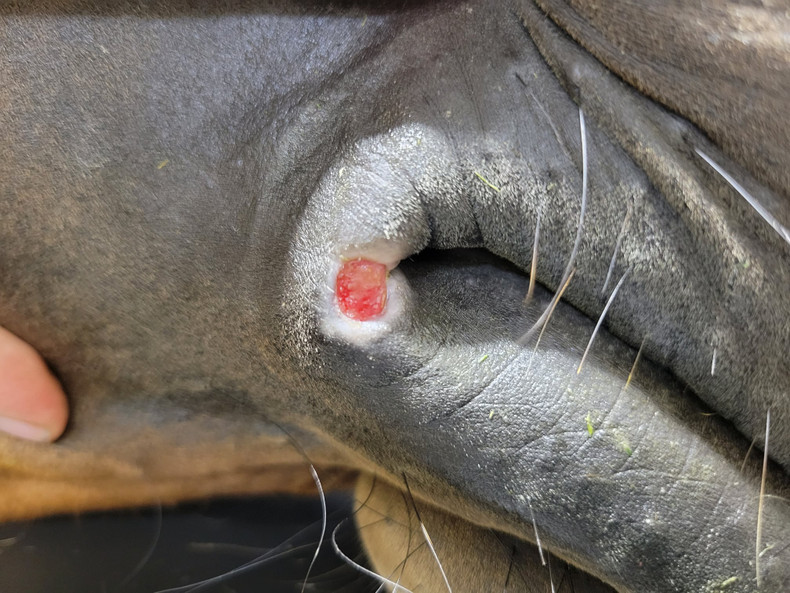Summer Sores (Cutaneous Habronemosis, Habronemiasis, Granular Dermatitis, Jack Sores) are wounds or lesions that occur mainly in the summertime on horses or ponies. They will sometimes go away on their own in the cooler months but may recur when it gets warm again. This may go on for years if left untreated. The sores can develop anywhere but are commonly found in the lower corner (medial canthus) of the eye, in the corners of the lips around the mouth, and on the penis (urethral process, glans penis, preputial ring). The wounds will have little (1-2mm long) yellowish granules present that look like little grains of rice. The sores are also very itchy, and this can cause the horse to make the wounds even worse. If left untreated the lesions can become granulated and produce proud flesh.
What causes Summer Sores?
Summer Sores are caused by an infestation of the Habronema spp. larvae in the sensitive tissues of the horse or pony. Luckily, they do not affect humans. The migrating larvae cause irritation and inflammation of the mucous membranes and skin tissue. The larvae are deposited on mucous membranes or wounds on the horse by common stable or house flies. If ingested by the horse, the larvae will migrate to the stomach and become fully mature. This takes about 8 weeks. They will then pass eggs into the manure and the life cycle is complete when they are ingested by flies or fly larvae. The adult larvae are around 6-25mm long and rarely cause any problems for horses if they follow their normal lifecycle in the digestive system. Because they are small, they can be difficult to diagnose via fecal egg count or gastric endoscopy.
How do I treat Summer Sores?
Treat by following the prevention method first. Your veterinarian may recommend topical and or intravenous corticosteroids and anti-inflammatories to control the itching and promote wound healing. They may also have to surgically remove or debride the wound of any granulation tissue or if there is an excessive amount of larvae present. Antibiotics may also be recommended for any secondary infections. If possible, wounds should be bandaged to prevent reinfection by flies. You may notice that the lesions seem to get worse before they get better. This happens because the larvae are agitated by the treatments and become more active before they die causing the tissues to become even more inflamed and itchy. Anti-inflammatories should help prevent this from happening.
How do I prevent Summer Sores?
Treating with a “mectin” (macrocyclic lactone) based wormer can kill the Habronema worms that are present in the stomach and prevent eggs from being picked up by flies or their larvae. Ivermectin is the most common, but Moxidectin or Abamectin is also effective. Some horses are predisposed to getting Summer Sores. These horses may need to be treated more often. A general guideline is to treat in the spring before flies become a problem to break the life cycle. Older or horses that get Summer Sores easily, may even be treated again a week later. Your veterinarian may even suggest a third treatment.
You can also break the cycle by reducing the fly population as much as possible. This can be done by:
- Keeping paddocks and stables clean and free of manure.
- Keep feed bins clean.
- Compost manure and food scraps. The heat created will kill the larvae.
Care should be taken to keep your horse or pony as fly-free as possible. This can be the trickiest part. Fly repellents, fly masks, fly boots, and fly sheets are all options to consider to help prevent flies from depositing the larvae on your horse or pony. Older horses and ponies should have regular health checks to make sure their immune systems can cope.


